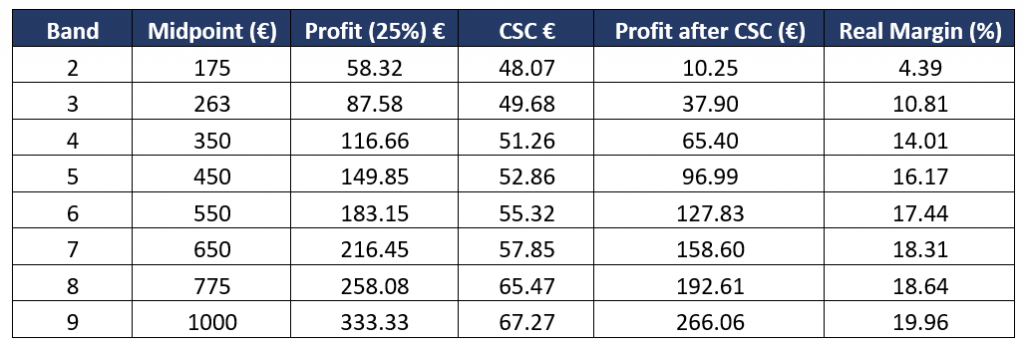
In a written communication to each of their retail customers that have a CSC applied, EM News has advised that a decision had been taken to increase the charge in each of the 9 Bands they operate. This is universally applied to each of the Bands equally and is a 1.9% increase to the current charges, which have been in place since early 2020.
In the UK, where the owners of EM News operate as Menzies, the increase will be 3.5%. It is to be noted that a number of years ago, EM indicated to the Association that they wished to implement a change to the Band system that has been used in Ireland for over 30 years , changes that we rejected on the grounds that they would hurt the medium-sized news retailer.
EM News carried out an exercise in recent times to calculate the average weekly purchases from each of their CSC-paying customers, using the 13- week period of weeks 27 to week 39 (10 June ’21 to 02 Sept ’21). This period was selected as retail had re-opened from 17th May and a degree of “normality” was returning. It is important to understand that the figures used to calculate CSC excludes VAT and levies and includes all credits for unsolds and processed claims for non-delivery and shortages.
When these calculations were completed, EM News shared the following information:
Most customers will stay in their current Band, the actual figure is 83%. These customers will, from April 9th, pay an additional 1.9%. In monetary terms, this ranges from an €0.84 cent increase (Band 1) to a €1.25 increase for those in Band 9.
We need to understand that although the sales of news and magazines continue to decline (not quite as pronounced in the Covid period it should be noted), there were two significant increases in RRP implemented in each of the previous two Christmas periods. These increases in RRP cushioned the volume declines and actually improved the overall profitability of the sector given the unique methodology of wholesale price setting (discounts off the VAT-Exclusive RRP).
EM News advised the Association that 5% of those measured had lower weekly average purchases in the 13 week period when compared against the control period of 2019, to the extent that they would migrate downwards from one Band to a lower one. As an example , average purchase of €420 per week in 2019 placed the customer in Band 5 but now has purchases of €390 which would move them into Band 4. In this instance, the current CSC is €51.87 and the new one will be €51.26, a reduction in real terms of 61cent.
Finally, for those 12% that will see an increase greater than 1.9%, this is due to increases in purchases to the extent that they have migrated from one Band to another.
A customer with purchases of €550 per week in 2019 and captured as having €620 average purchases moves from Band 6 to Band 7. In monetary terms this movement will see the current CSC of €54.29 replaced by the new €57.85, an increase of €3.56 per week or 6.56%.
The most unfair aspect of CSC is the effect it has is disproportionate. It is not truly progressive given the starting point (the minimum charge for 7-day delivery) is €44.85.
What this means is that retailers selling newspapers at the printed cover price which have a discount rate ranging from 22.00% to 27.5% can see the industry-average profit margin of 25% reduced very significantly due to the malevolent influence of carriage charges.
For those on the EM Band 1, the sale of newspapers and magazines is nothing more than a costly effort. The 0-€125 purchase would incur a LOSS once the CSC of €44.85 is applied.
A retailer selling 50 Sun each week, 34 Irish Daily Mail, 8 Sun Sunday and 10 Irish Mail on Sunday would have a VAT-exclusive intake of €167.71, giving a profit of €42.90 once purchase costs of €124.81 are paid. This profit is wiped out entirely by the CSC of €44.65, making a LOSS of €1.75. Irish publishers need to understand that the companies they engage to distribute their titles are choking the route to market and most certainly there is a case for a single newspaper and magazine distributor given the fact that these charges are not limited to EMN, they are paralleled in Newspread, making the sale of these products a very expensive and environmentally-unsustainable proposition.
We carried out the following exercise to show the disproportionate effect that retailers experience selling the titles.
We used the mid-point of each Band from 2 to 9 to show the real profit enjoyed from sales that are notionally 25%.

The above table clearly illustrates the fallacy that offering a discount of 25% off an RRP will reward a retailer sufficiently for all of the additional administrative and handling of daily deliveries and returns. Those on Bands 1 to 4 are carrying out an important function in the spread of democratic discourse but the reward is lower than the cost of running our stores, CSC needs to be reconsidered.